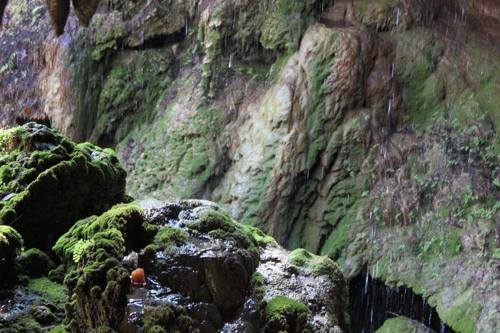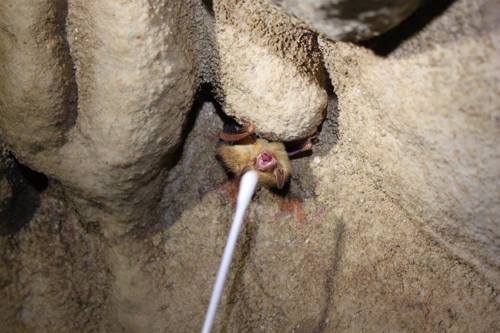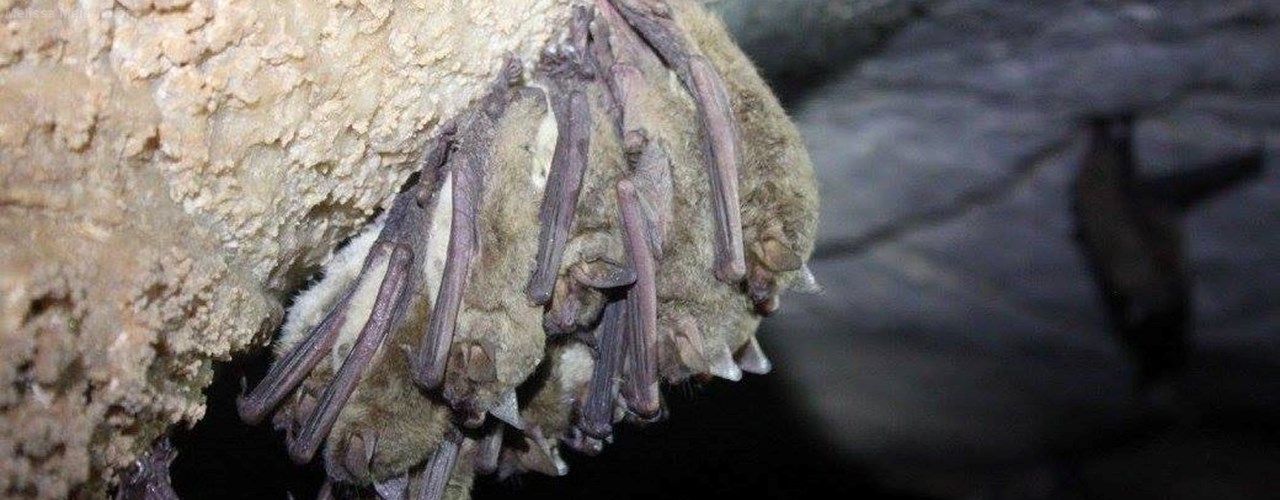White-nose syndrome 101
You may have heard of the deadly bat disease known as white-nose syndrome, but what exactly is white-nose syndrome, and how and when did it arrive in the United States? What is the current status of the disease’s spread? Well, we have the answers you are looking for.
What causes WNS?
White-nose syndrome (WNS) is a disease affecting hibernating bats. The disease, named for the distinct white fungus that appears on the muzzle, ears and/or wing membranes of hibernating bats, has led to widespread mortality of bats in eastern North America. The fungus, Pseudogymnoascus destructans, or P. destructans, grows in cold and humid environments, such as caves where bats are commonly found hibernating.
In February 2006, researchers first documented evidence of WNS in a photograph taken of a bat in Howes Cave just west of Albany, New York. Since then, the fungus that causes WNS has spread north into Canada, and south and westward across the United States.
The fungus spreads from bat-to-bat and can also spread from humans into bat environments. Thus, anyone who works around bats follows the white nose syndrome decontamination procedure to help reduce the spread of the fungus.
The cold-adapted fungus causing the disease irritates the skin of the bat, disrupting its hibernation and causing it to deplete its fat reserves at a faster rate.
 The view from inside a Texas cave.
The view from inside a Texas cave.
Where did the fungus come from?
It is assumed that the fungus was transmitted by a person to North America from either a European or Asian country where the fungus is also documented. However, bats in those countries do not develop the disease like the bats in North America.
If the fungus is present, does that mean white-nose syndrome will develop?
No. There are certain bat species that can carry the fungus but never develop the disease. This means that those species are unaffected by WNS. Below is a list of bat species that have been documented with the fungus (P. destructans positive) and bat species that have been confirmed with WNS (e.g. documented lesions, mortality) at this time in North America.
As the fungus continues to spread west, more bats are coming into contact with it. Because the disease does not develop within the first year of documenting the fungus, bats in the P. destructans positive column may end up in the WNS positive column.
|
P. destructans positive bats |
WNS positive bats |
|
Eastern red bat (Lasiurus borealis)* |
Big brown bat (Eptesicus fuscus)* |
|
Silver-haired bat (Lasionycteris noctivagans)* |
Eastern small-footed bat (Myotis lebii) |
|
Rafinesque’s big-eared bat (Corynorhinus rafinesquii)* |
Gray bat (Myotis grisescens) |
|
Virginia big-eared bat (Corynorhinus townsendii virginianus) |
Indiana bat (Myotis sodalis) |
|
Cave bat (Myotis velifer)* |
Little brown bat (Myotis lucifugus) |
|
Townsend’s big-eared bat (Corynorhinus townsendii)* |
Northern long-eared bat (Myotis septentrionalis)* |
|
|
Southeastern myotis (Myotis austroriparius)* |
|
|
Tricolored bat (Perimyotis subflavus)* |
|
|
Yuma bat (Myotis yumanensis)* |
An * indicates bat species found in Texas.
Have the fungus or the disease been found in Texas?
P. destructans has been found in Texas. Earlier in 2017 it was detected on three bat species in the Texas counties of Childress, Collingsworth, Cottle, Hardeman, King and Scurry.
The WNS disease has not been detected in Texas.
 To test for the fungus, bats are swabbed using a sterile Q-tip.
To test for the fungus, bats are swabbed using a sterile Q-tip.
How does the disease affect hibernating bats?
This fungus invades through tissue layers and disrupts the behavior of hibernating bats. Not all bat species are affected the same, however. There are some factors, such as life history (e.g. how long do they hibernate, and do they cluster?) and body condition (e.g. are they a smaller bat?) that affect the outcome. For example, researchers have found that bats that are smaller and wetter during hibernation tend to be impacted more by the disease.
Below are some symptoms indicative of bats having WNS:
- Frequent arousals from hibernation leading to fat reserves being used quicker than normal
- Skin lesions
- Death – 70-90% of bats affected succumb to the disease, and in some cases, it is near 100%
Is there a cure for the disease?
No. However, there are some potential interventions being researched. These treatments, some of which include naturally occurring bacteria that seem to limit the growth of the fungus, need to be carefully tested before being used in the environment.



 Cave myotis roosting in a cluster
Cave myotis roosting in a cluster